US jobs report preview: Could a weak report help bolster easing expectations?

Table of Content
Friday brings the US employment market back into focus, as traders seek to weigh up the likeliness of a soft or hard landing. With a wide disparity between Fed and market expectations over rates in 2024, traders will be sensitive to any potential data or event that could narrow this gap in one way or another. Let’s look at some of the key considerations for traders approaching this key event.
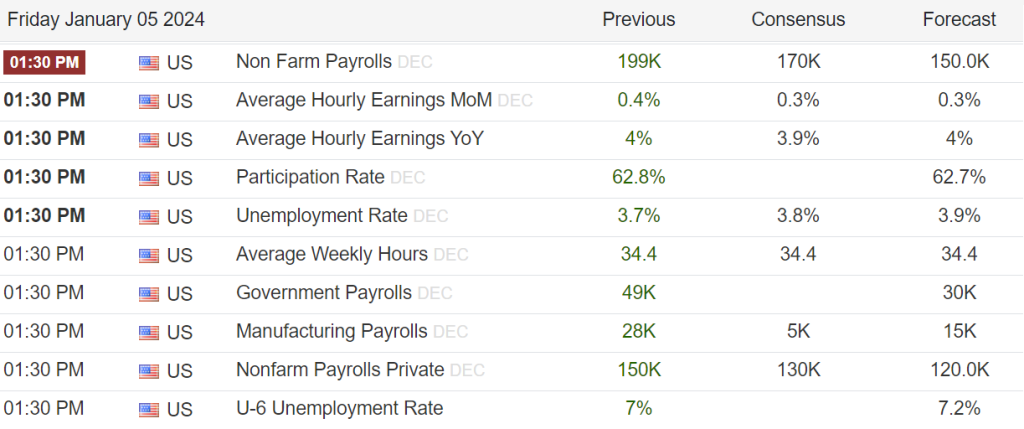
Interest rate expectations
The backdrop to this announcement remains the outlook for interest rates this year. with markets continuing to predict a first rate cut in March. There will be plenty of conjecture over whether we will indeed see that March cut come to fruition, with the latest Fed minutes signalling that the committee were yet to begin discussions over the timing of any initial pivot into lower rates. A strong jobs report would help bolster the idea that the Fed will hold off for longer than markets currently expect, thus lifting the dollar to the detriment of risk assets such as equities. Conversely, a weakening jobs market would help support the notion that we will see a March rate cut from the Fed.
Another notable element of the table below is that markets are currently pricing a whopping 150-basis points worth of rate cuts this year. This flies in the face of the 75-basis points worth of easing laid out within the latest Fed dot plot. A stronger or weaker than expected jobs report could help shift expectations over whether the Fed will need to enact such a steep reduction to rate this year or not.

US non-farm payrolls
Let’s look at some of the key factors to consider when looking ahead to the impending payrolls release. Firstly, the privately produced ADP payrolls figure represents the most obvious indicator that could provide a directional signal of where to look on Friday. This month we saw a surprisingly strong ADP figure of 165k, although we can see there is a somewhat questionable link between the headline and ADP payrolls figures over the years. This should warn traders off utilizing this ADP strength as the basis for expecting something similar for the headline figure.
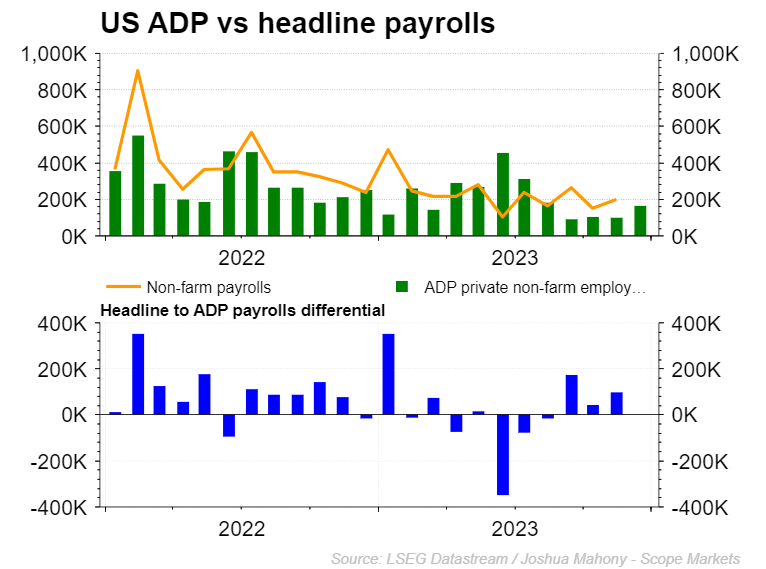
A breakdown on the sources of recent job growth highlights the trade weakness seen last month negating the manufacturing rebound seen after a difficult October. Markets are pointing towards an expected decline to the 170k region, following last month’s 199k figure. This would mark a continuation of the downtrend seen over the past 18 months.
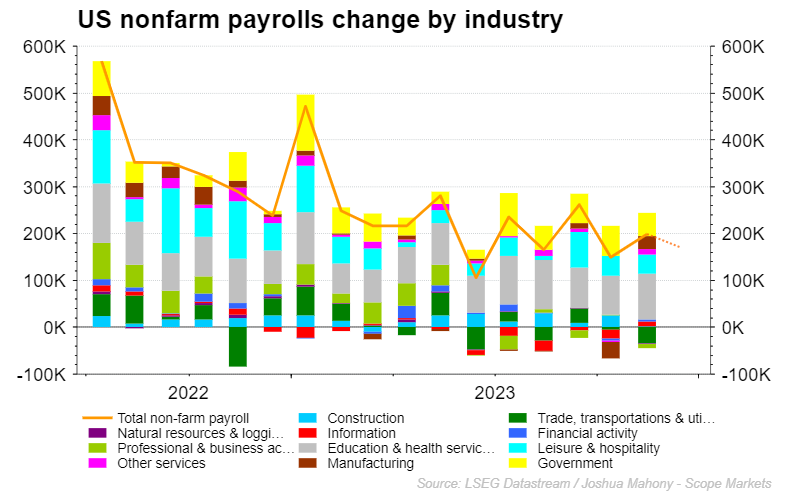
Unemployment
We are yet to see any notable uptick in unemployment thus far, with the December figure of 3.7% coming off the back of an unexpected decline last month. A push through 4% would perhaps start to highlight the growing concerns that higher rates are having a tangible impact on the jobs market. However, we are yet to see it. Below we have a number of correlated indicators, which we follow for signs of a potential impending rebound in US unemployment. The recent decline in JOLTS job openings is a potential warning signs, building on the weakness seen over much of the past year. Nonetheless, we are yet to see any dramatic movement across all four indicators below, covering the JOLTS, CB ratio, initial, and continuing jobless claims.
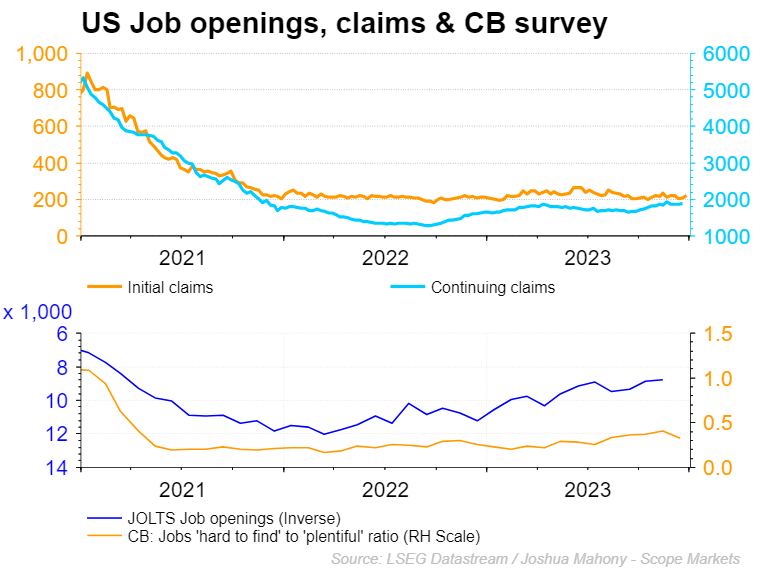
Looking at the composition of the US unemployment, last month’s unexpected decline seems to have taken place primarily within those who have been without a job for 15 weeks or more. With the participation rate rising last month, this cannot be a case of long-term unemployed simply removing themselves from the market. We can also see a welcome decline in the ratio between those that have found work “hard to come by” compared with “plentiful.” This highlights the notion that the US jobs remains some way of any particular warning sign that could push the Fed into a sharp dovish turn.
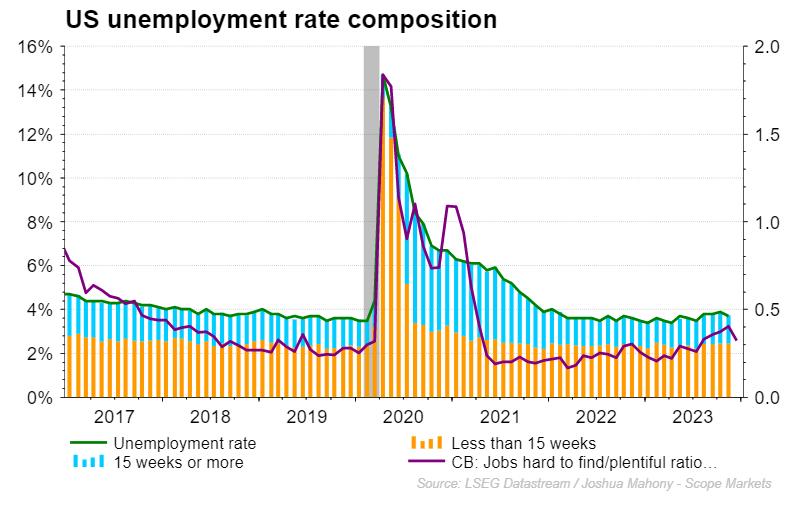
Average hourly earnings
Wages provide the third major element of the jobs report, with this figure becoming increasingly proxy given its role as a proxy for underlying inflation pressures for businesses. That relationship can be seen below, with the downward trajectory in wage growth playing out alongside the core CPI slide. With markets seeing disinflation as grounds for optimism over the pace and timing of the Fed easing path, a notable slide in wage growth would boost hopes for a March rate cut. By adding the 3-month annualized wage growth figure, we can see that the recent pace of wages has been in line with pre-pandemic levels, highlighting the reason why many are optimistic that the Fed will look beyond the historic readings and focus on the current trajectory. With markets looking for a figure of either 4% or 3.9%, a sub-4% reading could help bolster confidence for the bulls.
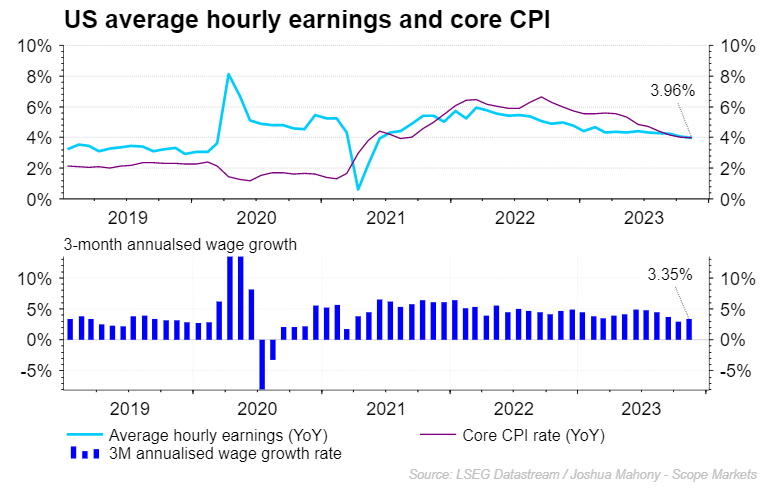
US dollar technical analysis
The dollar has been on the rise of late, with market jitters helping to push the DXY into a third trendline touch. This rise brough price through the 50% Fibonacci retracement level, falling short of 61.8% for now. A particularly strong jobs report could help further this recent recovery, but the downtrend does remain intact unless we see price rise through the 103.98 level. Weith the stochastic oscillator likely to rise into overbought territory over the coming days, there is a good chance that we see the sellers come back into play before long. This bearish trend would be encouraged in the event of a poor jobs report (weak payrolls, rising unemployment, lower wages growth).
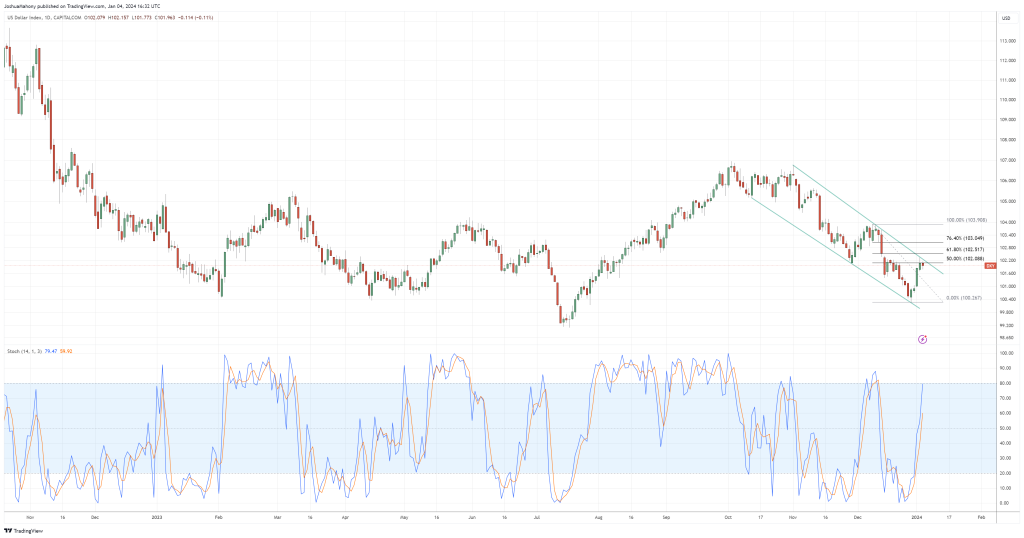
Disclaimer: This material is a marketing communication and shall not in any case be construed as an investment advice, investment recommendation or presentation of an investment strategy. The marketing communication is prepared without taking into consideration the individual investors personal circumstances, investment experience or current financial situation. Any information contained therein in regardsto past performance or future forecasts does not constitute a reliable indicator of future performance, as circumstances may change over time. Scope Markets shall not accept any responsibility for any losses of investors due to the use and the content of the abovementioned information. Please note that forex trading and trading in other leveraged products involves a significant level of risk and is not suitable for all investors.







